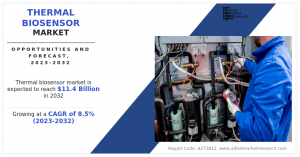Thermal Biosensor Market to Surge at a Robust Pace in Terms of Revenue Over 2032
Thermal Biosensor Market Expected to Reach $11.4 Billion by 2032—Allied Market Research
Download Research Report Sample & TOC: https://www.alliedmarketresearch.com/request-sample/A273812
Thermal biosensors reflect the changes in temperature within the biological reaction medium. It refers to measuring the changes in the temperature of the circulating fluid following the reaction of a suitable substrate with the immobilized enzyme molecules. The devices used are referred to as enzyme thermistors.
Thermal biosensors have a wide array of applications, showcasing their adaptability and significance. In the healthcare sector, they are frequently employed in medical thermometers for gauging body temperature. For instance, amid the COVID-19 pandemic, thermal biosensors played a pivotal role in screening for fever at airports and healthcare facilities, aiding in the early identification of potential infections, which provided a boost to the thermal biosensor market growth. Another notable application lies in glucose monitoring systems for individuals with diabetes. In this context, thermal biosensors supply real-time information on blood glucose levels, empowering individuals to make informed choices regarding insulin dosages and dietary habits. In the sphere of environmental monitoring, these sensors are utilized to track fluctuations in temperature within ecosystems or industrial processes, contributing to researchers' comprehension and mitigation of temperature-induced effects on living organisms.
Moreover, thermal biosensors assume a critical role in the food industry. They are utilized to oversee and regulate the temperature of perishable goods during their transportation and storage. For example, in the cold chain logistics of vaccines, thermal biosensors ensure that vaccines remain within safe temperature ranges, safeguarding their effectiveness. In research laboratories, thermal biosensors are enlisted for a variety of applications, encompassing investigations into enzyme kinetics, protein-protein interactions, and DNA hybridization events. On the whole, the versatility and precision of thermal biosensors establish them as invaluable instruments across a broad spectrum of industries and scientific endeavors.
Get Customized Reports with you're Requirements: https://www.alliedmarketresearch.com/request-for-customization/A273812
The increase in demand for food safety serves as a compelling force driving the growth of the thermal biosensor market. The necessity for reliable and swift methods of assessing food safety is important with a growing global population and intricate food supply chains. Thermal biosensors, renowned for their ability to detect contaminants, allergens, and pathogens in food products, provide a robust solution. These biosensors include food producers and regulatory bodies to quickly and accurately identify potential risks, ensuring that the food supply chain remains free from harmful substances and pathogens. Furthermore, the stringent food safety regulations and consumer awareness have placed added pressure on the food industry to maintain the highest standards using thermal detection biosensors. Thermal biosensors confer a competitive advantage by delivering real-time, label-free analysis, facilitating early detection of food safety issues, and enabling proactive measures to prevent tainted products from reaching consumers.
Competitive Analysis:
The Thermal Biosensor industry's key market players adopt various strategies such as product launch, product development, collaboration, partnership, and agreements to influence the market. It includes details about the key players in the market's strengths, product portfolio, market size, and share analysis, operational results, and market positioning.
Some of the major key players in the global Thermal Biosensor Market include,
DowDupont Inc.
LifeSignals
Nova Biomedical Corporation,
Masimo Corporation
Siemens
Fitbit (Google)
Garmin
TA Instruments
Procure Complete Report: https://www.alliedmarketresearch.com/checkout-final/33c2b6b09d6139e7b77390d1a7c8a581
The Thermal biosensor market is analyzed by application, distribution channel, and region. Based on application, the market is bifurcated into point-of-care (POC), home diagnostics, research labs, food and beverages, environmental monitoring, and biodefense. In 2022, the above point-of-care (POC) segment dominated the market, and it is expected to acquire a major market share by 2032. Based on the distribution channel, the thermal biosensor market analysis is bifurcated into online and offline. In 2022, the above offline segment dominated the market, and the online segment is expected to acquire a major market share by 2032.
Based on region, the thermal biosensor market trends are analyzed across North America (the U.S., Canada, and Mexico), Europe (the UK, Germany, France, and the rest of Europe), Asia-Pacific (China, Japan, India, South Korea, and rest of Asia-Pacific), and LAMEA (Latin America, Middle East, and Africa).
Inquiry before Buying: https://www.alliedmarketresearch.com/purchase-enquiry/A273812
KEY FINDINGS OF THE STUDY
- The global thermal biosensor market size was valued at $5,058.0 million in 2022 and is projected to reach $11,442.4 million by 2032, registering a CAGR of 8.5% from 2023 to 2032.
- The point-of-care (POC) segment was the highest revenue contributor to the market, with $1,371.6 million in 2022.
- The offline segment was the highest revenue contributor to the thermal biosensor market share, with $3,283.3 million in 2022, and is estimated to reach $7,235.0 million by 2032, with a CAGR of 8.2%.
- North America was the highest revenue contributor, accounting for $2,090.0 million in 2022, and is estimated to reach $4,462.5 million by 2032, with a CAGR of 7.9%.
- Europe is estimated to reach $3,446.5 million by 2032, at a significant CAGR of 8.5%.
About Us:
Allied Market Research is a top provider of market intelligence that offers reports from leading technology publishers. Our in-depth market assessments in our research reports take into account significant technological advancements in the sector. In addition to other areas of expertise, AMR focuses on the analysis of high-tech systems and advanced production systems. We have a team of experts who compile thorough research reports and actively advise leading businesses to enhance their current procedures. Our experts have a wealth of knowledge on the topics they cover. Also, they use a variety of tools and techniques when gathering and analyzing data, including patented data sources.
David Correa
Allied Market Research
+ 1800-792-5285
email us here
Visit us on social media:
LinkedIn
Facebook
YouTube
X
Legal Disclaimer:
EIN Presswire provides this news content "as is" without warranty of any kind. We do not accept any responsibility or liability for the accuracy, content, images, videos, licenses, completeness, legality, or reliability of the information contained in this article. If you have any complaints or copyright issues related to this article, kindly contact the author above.
Madison Seating Unveils Ergonomic Steelcase Office Chairs For Employee Well-being
Gary Brecka Hydrogen Water Bottle Brand Recommended by Hydrogen Water Bottle Co
Imperial, a Villa Center Unveils Major Remodel
Więcej ważnych informacji
 Jedynka Newserii
Jedynka Newserii

 Jedynka Newserii
Jedynka Newserii

Bankowość

Rośnie liczba i wartość udzielonych konsumentom kredytów gotówkowych. Gorzej mają się kredyty ratalne oraz te udzielane firmom
Rynek kredytowy w Polsce co do zasady rośnie, choć nierównomiernie. Z danych Biura Informacji Kredytowej wynika, że najlepiej rozwija się segment kredytów gotówkowych dla konsumentów. Wartościowo wzrosła też kwota udzielonych limitów w kartach kredytowych. Według prognoz BIK w całym roku wzrośnie wartość zarówno udzielonych kredytów mieszkaniowych, jak i gotówkowych, choć tych pierwszych poniżej inflacji. Wcześniejsze cięcia stóp procentowych przez RPP nie zmieniły tej prognozy.
Transport
37,5 proc. środków z Planu Społeczno-Klimatycznego trafi na walkę z ubóstwem transportowym. Organizacje branżowe apelują o zmianę priorytetowych projektów [DEPESZA]

Ministerstwo Funduszy i Polityki Regionalnej z końcem czerwca zakończyło konsultacje Planu Społeczno-Klimatycznego, który otwiera drogę do pozyskania 65 mld zł (11,4 mld euro) z unijnego Społecznego Funduszu Klimatycznego. Polska będzie jego największym beneficjentem, a 37,5 proc. budżetu zostanie przeznaczone na bezpośrednie wsparcie osób narażonych na ubóstwo transportowe. Organizacje branżowe oceniają jednak, że walka z tym zjawiskiem może się okazać nieskuteczna. W toku konsultacji zgłosiły swoje zastrzeżenia co do priorytetów w wydatkach i sposobu wsparcia inwestycji w transport rowerowy.
Prawo
Firmy będą mogły przetestować krótszy tydzień pracy z rządowym wsparciem. Nabór wniosków ruszy w sierpniu

Ministerstwo Rodziny, Pracy i Polityki Społecznej uruchamia pilotaż krótszego tygodnia pracy. Zainteresowane wzięciem w nim udziału firmy będą się mogły ubiegać o wsparcie finansowe ze strony rządu. Politycy Nowej Lewicy, którzy są pomysłodawcami testu tego rozwiązania, przekonują, że finalnie zyskają na nim wszyscy, zarówno pracownicy, jak i pracodawcy, a ostrzeżenia o spodziewanych problemach gospodarki są mocno przesadzone.
Partner serwisu
Szkolenia

Akademia Newserii
Akademia Newserii to projekt, w ramach którego najlepsi polscy dziennikarze biznesowi, giełdowi oraz lifestylowi, a także szkoleniowcy z wieloletnim doświadczeniem dzielą się swoją wiedzą nt. pracy z mediami.

![37,5 proc. środków z Planu Społeczno-Klimatycznego trafi na walkę z ubóstwem transportowym. Organizacje branżowe apelują o zmianę priorytetowych projektów [DEPESZA]](https://www.newseria.pl/files/1097841585/rower3,w_85,_small.jpg)







.gif)

 |
| |
| |
|